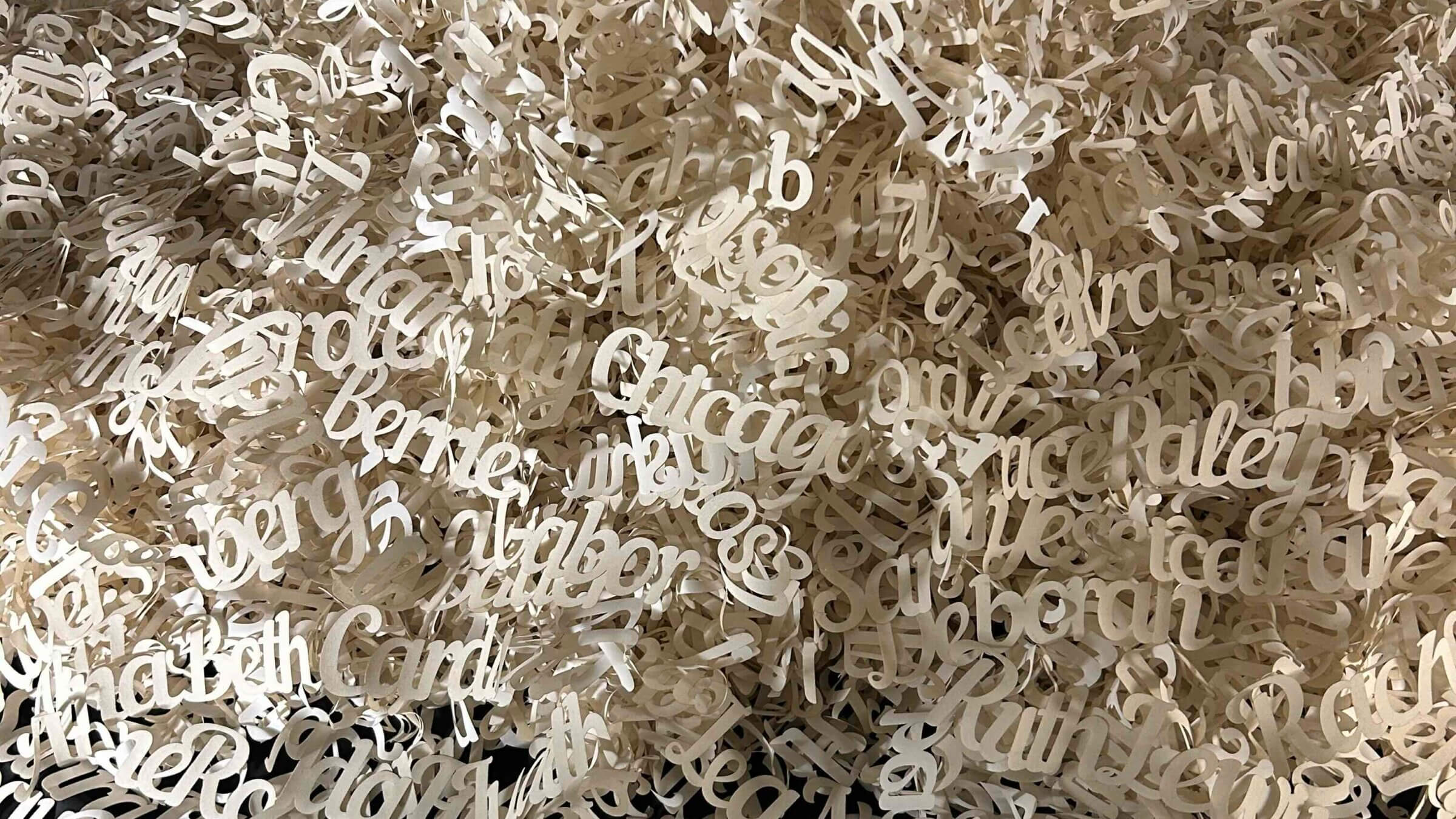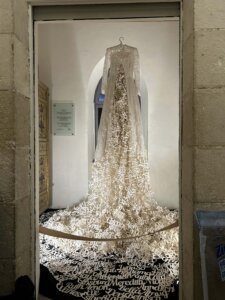How one wedding dress came to symbolize the strength of more than 2,000 Jewish women
Andi Arnovitz is one of seven contemporary artists in ‘Threading,’ an exhibition at the Jerusalem Biennale

For ‘What We Bring,’ Arnovitz laser cut names of impactful women from white bookbinding cloth. Photo by Yair Medina
The theme of the 6th Jerusalem Biennale — delayed until now due to the Oct. 7 attack and the war in Gaza — is tzon barzel, or, “iron flock,” which refers to a Talmudic concept that property a woman brings to her marriage remains hers, regardless of the fate of the marriage. In modern Hebrew, this phrase refers to someone who is a cultural asset to the Jewish people.
Curated by Emily Bilski, “Threading,” one of 30 exhibitions at the Biennale, uses textile arts to explore “the abundant reservoir of cultural assets created by Jewish women.” “Threading” features work by seven contemporary artists nestled amongst the permanent historical artifacts of the Museum of Italian Jewish Art, many of them textiles repurposed from their daily household use into religious objects such as Torah binders.
Several of the “Threading” artists were inspired by this practice of “upcycling” textiles. In a particularly striking creation, artist Andi Arnovitz transformed her wedding dress into a magnificent statement on the power of Jewish women, entitled “What We Bring.” Arnovitz split her own wedding dress in two, and laser cut 2,611 names of impactful Jewish women — including Deborah Lipstadt, Bella Abzug, Bette Midler, Barbara Streisand, Ruth Bader Ginsburg, Eva Hesse and Gilda Radner — from white bookbinding cloth, which is fluid yet strong. Arnovitz imagined these names, which she found on the Jewish Women’s Archive site, “bursting out of this wedding dress,” she said. “There’s no way to contain this wealth of cultural assets — these Jewish women have changed history — we are who we are because of them.”

Arnovitz said she “pulled out names that meant something to me, from my generation,” and positioned them at the bottom, so that they create a huge circle on the floor, and are easily read.
The dress was handmade by her grandmother, who sewed the pearls on. Her father and grandmother owned fabric stores in Kansas City — LaVine Fabrics.
“From the time I was a little girl,” Arnovitz said, “I was surrounded by fabrics and people sewing. It’s in my blood, it’s under my skin.” She has continued this family tradition by bringing sewing and weaving into many previous artworks, such as “Heavy” (2020), a shroud with 50,000 discs representing the number of civilians killed in the Syrian civil war, and the giant “Vest of Prayers” (2009), which she calls “the antithesis of a suicide vest; it’s a hopeful vest and who we are as the Jewish people.”
Whereas a suicide vest is filled with sharp bolts and nuts designed to maximize injury, “the ultimate Jewish tool,” she says, “is prayer and paper.” Arnovitz rescued several dozen prayer books she found discarded in Mea Shearim, rolled pages into scrolls, then wrapped and tied them with silken thread.
Arnovitz sees a connection between the physical gestures she makes creating these garments and the gestures of Jewish ritual.
“I personally think,” she said, “there is a whole set of gestures that are uniquely Jewish — wrapping, binding, winding and tying, and gestures that appear over and over again in Jewish ritual. We bind Torah, men wrap tefillin, Jewish women when we light candles, we bring light to our eyes three times, we braid challah, the bride walks around the groom seven times — these gestures repeat over and over again.”
The repetition of these Jewish rituals create collective Jewish memory. When we wrap tefillin or light candles we are re-enacting the gestures Jewish men and women made thousands of years before us.
In making “What We Bring,” Arnovitz repeats these gestures: she bound the names to each other by sewing them together; she wrapped the names around the dress, creating what she calls a “circle of strength”; she tied the threads of each name to the dress and to each other. Perhaps that’s why this work wields such evocative strength, connecting us to generations of Jewish women before us.
Though created before Oct. 7, “What We Bring” speaks to the resilience of Jewish women; it reclaims and reasserts Jewish women’s power after Hamas’ barbaric use of rape to try to humiliate and degrade Jewish women. The dress, suspended in air, cascading to the floor, is both ethereal and powerful, graceful and strong, a symbol of the strength and beauty of Jewish women, in Israel and the world. “It is a Jewish feminist statement that’s badly needed right now,” Arnovitz said.















